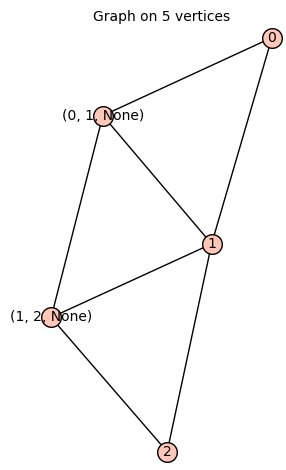Revision history [back]
 | 1 | initial version |
There is a subdivide_edges method but it doesn't seem to give control over the names of the new vertices.
If I understood the definition correctly then the implementation can go like this:
def total_graph(G):
T = Graph([G.vertices() + G.edges(), G.edges() + G.line_graph().edges()])
for (a,b,l) in G.edges():
T.add_edge(a, (a,b,l))
T.add_edge(b, (a,b,l))
return T
Example 1:
sage: graphs.PathGraph(2).edges()
[(0, 1, None)]
sage: total_graph(graphs.PathGraph(2)).edges(sort=False)
[(0, 1, None), ((0, 1, None), 0, None), ((0, 1, None), 1, None)]
Example 2:
sage: graphs.PathGraph(3).edges()
[(0, 1, None), (1, 2, None)]
sage: total_graph(graphs.PathGraph(3)).edges(sort=False)
[((0, 1, None), (1, 2, None), None), (0, 1, None), ((0, 1, None), 0, None), (1, 2, None), ((0, 1, None), 1, None), ((1, 2, None), 1, None), ((1, 2, None), 2, None)]
sage: total_graph(graphs.PathGraph(3))

 | 2 | No.2 Revision |
There is a subdivide_edges method but it doesn't seem to give control over the names of the new vertices.
If I understood the definition correctly then the implementation can go like this:
def total_graph(G):
T = Graph([G.vertices() + G.edges(), G.edges() + G.line_graph().edges()])
G.union(G.line_graph())
for (a,b,l) in G.edges():
T.add_edge(a, (a,b,l))
T.add_edge(b, (a,b,l))
return T
Example 1:
sage: graphs.PathGraph(2).edges()
[(0, 1, None)]
sage: total_graph(graphs.PathGraph(2)).edges(sort=False)
[(0, 1, None), ((0, 1, None), 0, None), ((0, 1, None), 1, None)]
Example 2:
sage: graphs.PathGraph(3).edges()
[(0, 1, None), (1, 2, None)]
sage: total_graph(graphs.PathGraph(3)).edges(sort=False)
[((0, 1, None), (1, 2, None), None), (0, 1, None), ((0, 1, None), 0, None), (1, 2, None), ((0, 1, None), 1, None), ((1, 2, None), 1, None), ((1, 2, None), 2, None)]
sage: total_graph(graphs.PathGraph(3))


